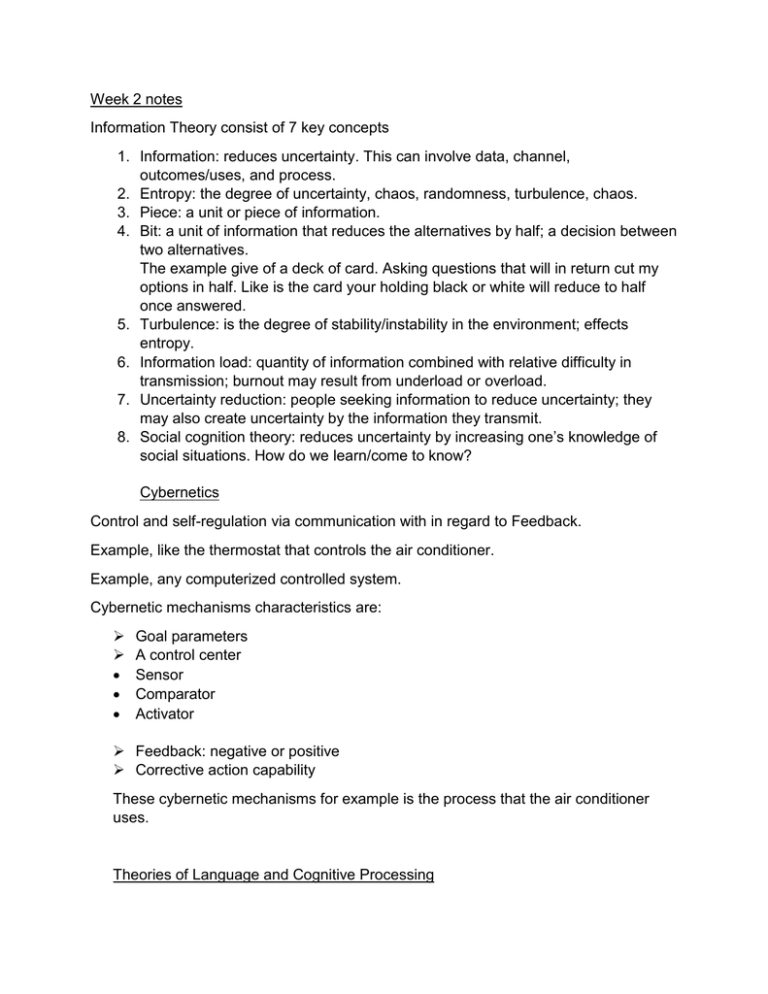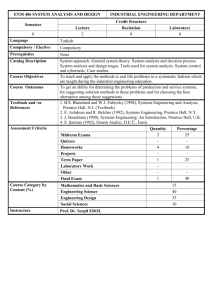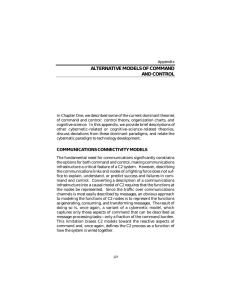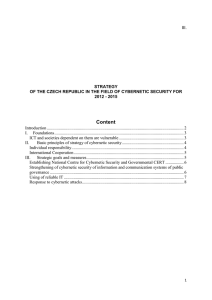Week 2 notes
advertisement

Week 2 notes Information Theory consist of 7 key concepts 1. Information: reduces uncertainty. This can involve data, channel, outcomes/uses, and process. 2. Entropy: the degree of uncertainty, chaos, randomness, turbulence, chaos. 3. Piece: a unit or piece of information. 4. Bit: a unit of information that reduces the alternatives by half; a decision between two alternatives. The example give of a deck of card. Asking questions that will in return cut my options in half. Like is the card your holding black or white will reduce to half once answered. 5. Turbulence: is the degree of stability/instability in the environment; effects entropy. 6. Information load: quantity of information combined with relative difficulty in transmission; burnout may result from underload or overload. 7. Uncertainty reduction: people seeking information to reduce uncertainty; they may also create uncertainty by the information they transmit. 8. Social cognition theory: reduces uncertainty by increasing one’s knowledge of social situations. How do we learn/come to know? Cybernetics Control and self-regulation via communication with in regard to Feedback. Example, like the thermostat that controls the air conditioner. Example, any computerized controlled system. Cybernetic mechanisms characteristics are: Goal parameters A control center Sensor Comparator Activator Feedback: negative or positive Corrective action capability These cybernetic mechanisms for example is the process that the air conditioner uses. Theories of Language and Cognitive Processing Theories of verbal coding. A sign is a stimulus that has meaning for people. Messages are sign and group of sign shaped through human though processes. Signal: indicates the presence of a object other than itself, time and contextbound. For example maybe dogs do not know what we are actually saying signals like waving hands or tone of voice gets communication across. Symbol: arouses in a person a conception of the object, event or condition context- free. For example, labels or a stop sign. Coding: the process of relating signs to their referents. For example, shaking hands. Signs are used it elicit and formulate behavior. Sings have relationship with other signs. In communication, one’s reality is represented to the self and others with signs. The study of signs and /or verbal coding can be approached three ways. Theories of Verbal Coding Semantics: how signs relate to things…meaning( what words mean) Pragmatics: how signs effect human behavior. Syntactic: signs relating to other signs Language is a structure sequence of speech sounds organized through rules or syntax. Speakers of language must acquire an intuitive knowledge of grammar. People must be able to use their knowledge of grammar to create and understand novel sentence. How do we develop language? How is language structured? Classical Structural Linguistics What are the syntactical units and relations within a sentence? Phonology: The study of sounds. Morphology: study of words, how do words come to be or form overtime. Syntactic: learning rules for grammar, or that language you speak. Lexical level: meanings of words and word combinations Psychological Approaches Ask how is language used? What mental processes are used in speech production and reception? Behavioristic: stimulus response (Skinner). Example, saying hello will make the other person say hello back. Conditioned, reinforced; affected by use frequency. Generative grammar (Chomsky) Concerned with novel sentences; (creating sentence from own point of view). Conceives the ideal speaker- listener. Competence and performances, key concepts Major syntactic concern is the difference between deep structure and surface structure. Deep structure: an abstract sentence mostly in the mind of the speaker. Surface structure: produced from deep structure through transformations. Language Acquisition Behaviorist: learned Nativist: innate Theories of Thinking Thinking involves conceptual behavior… two approaches to concept formation. Behavioristic Cognitive school( learning in school) Boume: a concept is formed whenever two or more distinguishable objects or events have been grouped or classified together on the basis of some common feature or property. For example, apple is the object that can to group by color or the fact that it is a food or fruit or what color the apple is. Conceptual behavior consists of: Concept formation: learning concepts. Concept utilization: their use in life. Cybernetic approach: Miller/ Galant/ Pribram Thinking involves planning. Thinking is a cybernetic mechanism that senses feedback and adjusts accordingly. Developed the TOTE model Test> Operate> Test> Exit.










